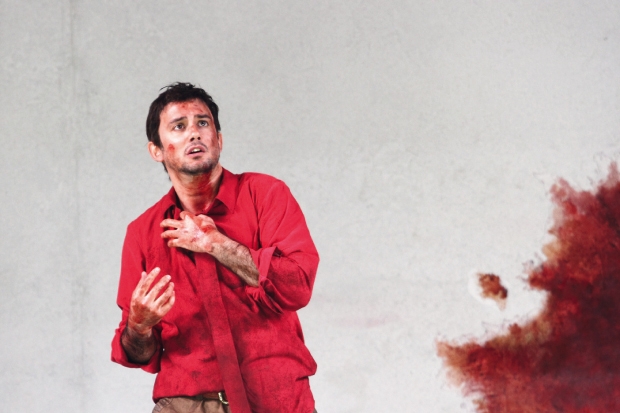Mozart’s first great opera, Idomeneo, is not often performed, and perhaps it’s better that way. It should be seen as a festival work, celebrating qualities that we rarely reflect on, but are of the utmost importance. In his fine essay on the opera, David Cairns writes that it encompasses ‘love, joy, physical and spiritual contentment, stoicism, heroic resolution; the ecstasy of self-sacrifice, the horrors of schizophrenia, the agonising dilemma of a ruler trapped in the consequences of his actions; mass hysteria, panic in the face of an unknown scourge, turning to awe before the yet more terrible reality; the strange peace that can follow intense grief. Idomeneo, finally, moves us because it holds out the possibility of human nobility in a context of unblinking psychological truth.’
For the contemporary opera director such words must seem very quaint: certainly for Martin Kusej, who directs the new Royal Opera production, and who presents Idomeneo as a work about regime change. Idomeneo is the king who has made the terrible vow to kill the first living thing he sees, doomed to kill his own son, whom he loves. Kusej presents him as a vicious tyrant who is only too eager to get rid of his more democratically minded heir, and who also fancies his son’s beloved, Ilia. And so on. The plot is systematically twisted and undermined, with the help of mendacious surtitles and projected stage directions, so that it becomes increasingly incoherent.
One thing that that shows is that Kusej hasn’t listened to Idomeneo’s music. The idiom of this, Mozart’s (to my mind) only wholly successful opera seria, is elevated, sometimes even earnest, and the idea that some of the characters are singing sweetly to conceal their poisonous intentions can gain no purchase. With the revolving grey and black set, characters disappearing through apertures (rather similar to ENO’s Figaro, as it happens), a troop of young boys in gym kit lining up to listen to Elettra’s first aria, and so forth, nothing much can gain a purchase; the spectator is left asking, even more often than in most contemporary productions, Why? What does that mean? Why does a dead shark appear in the middle of Act I? Why is Arbace, Idomeneo’s confidant, equipped with an accordion which he mercifully doesn’t play, and opaque spectacles? Maybe the answer to these and any other questions one has is meant to be found in the final tableau, where the words ‘Utopias fade, rebellions decay, the rulers remain’, more appropriate to Musorgsky than to Mozart, are projected on to the drop-curtain.
Fortunately, it was one of those evenings where I was able to separate my anger and distaste for the production from the musical performance, which I found for the most part enthralling, perhaps because it is too long since I last heard this masterpiece. Mark Minkowski gave an incisive account of the Overture, and never let up on the tension, which can easily happen in some of the reflective arias. He had a fine if not great set of singers, of whom the star was the Ilia of Sophie Bevan, moving as an actress and in wonderful voice. Her father-in-law to be, Idomeneo, is in the same class: Matthew Polenzani is one of the finest non-glamorous tenors around. More controversial is the Idamante of Franco Fagioli, not the voice one would introduce someone to if trying to convert them to the sound of the counter-tenor, but a passionate performer whose idiosyncrasies are worth adjusting to. Malin Byström, power-dressed and cliché-doused as Elettra, didn’t carry the guns of the greatest performers of the part, while Stanislas de Barbeyrac sang Arbace’s second aria better than anyone I have heard. Do see if there are any tickets left facing away from the stage.
The next evening Donizetti’s Les Martyrs was given in a concert performance to a packed Royal Festival Hall — an extraordinary indication of the changes in operatic fashion. The performance came after intensive recording sessions of the work for Opera Rara, and was extremely confident and polished. It was conducted, and presided over, by Mark Elder, with all the fervour of the convert. Quite a proportion of the very long evening was devoted to multiple bows from the soloists after individual numbers — not to be encouraged if we are to take Donizetti as dramatist seriously. Les Martyrs is the gallicised version of Poliuto, best known for the live performance in which Callas and Corelli star. Forgetting, or trying to forget them, I can’t feel that Les Martyrs improves on Poliuto, especially if the best bits of the revised score are back-transferred to its predecessor. Like everyone else, Donizetti wanted success as a purveyor of Parisian grand opéra, and that involves inflation and redundancy. Admittedly, the Overture is strange, beginning with a long passage for four bassoons, but is it good?
I don’t have space to enumerate the virtues of the soloists or to go into detail about the excellence of the Orchestra of the Age of Enlightenment. If I’m to be invidious, then Michael Spyres as Polyeucte provided the biggest thrills of the evening. Until the CDs appear, I would recommend the live recording from Bergamo in 1975 (not the Venice performance in 1978), with Leyla Gencer, supreme Donizetti soprano, as Pauline.






Comments